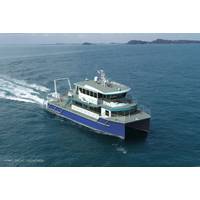
US, Australia to Unveil Submarine Pact to Counter China
Britain and help boost its economy's low growth rate.Under the initial AUKUS deal announced in 2021, the United States and Britain agreed to provide Australia with the technology and capability to deploy nuclear-powered submarines.It will be the first time the United States has shared nuclear-propulsion technology since it did so with Britain in the 1950s. Currently no party to the nuclear Non-Proliferation Treaty other than the five countries the NPT recognizes as weapons states - the United States, Russia, China, Britain and France - has nuclear submarines.In a second stage of the AUKUS project,

Incat Crowther Designs University of Wisconsin-Superior's New Research Vessel
vessel will be built by Louisiana shipbuilder Midship Marine for expected delivery in spring 2024.Described as a ‘floating classroom’, the 65-foot USCG-certified catamaran will support the university’s on-water education and research and features proven parallel hybrid battery propulsion technology to reduce greenhouse gas emissions and help meet the university’s environmental objectives.Incat Crowther has customised the design of the vessel, which can carry 49 passengers and eight crew, specifically to the needs of the LSRI. The main deck features two large state-of-the-art laboratori

ABB Propulsion Takes Ship to North Pole
also enables fuel consumption to be reduced by up to 20 percent compared to that of traditional shaftline marine propulsion systems.The Azipod system was first introduced in 1990 and has since been installed on more than 90 icebreaking vessels. Power ratings range from 1 MW to 22 MW, making the propulsion technology suitable for a wide range of vessels including cargo vessels, cruise ships, ferries, mega-yachts, offshore supply fleets, research vessels, wind turbine installation boats and drilling rigs.In addition, the latest versions of Azipod have been designed so that a ship consumes less fuel driving

Partners Aim to Transform Acoustic Monitoring
Acoustic Monitoring (WPAM) system. The field tests assessed the performance of the AutoNaut/WPAM for: self-noise, data transmission capabilities and optimal array deployment. Analysis of the trial data showed a very high Signal to Noise ratio. AutoNaut’s unique wave propulsion technology makes it an extremely quiet platform and, with proven reliability for long mission duration, there is clear potential for sound measurement and marine mammal monitoring. The full acoustic signal was transmitted in true real time from the USV by Seiche’s WPAM system. The next step will

Meet the AutoNaut
2014. Are there any new or innovative use technologies on our vessel that we won’t see on others? Please be specific. As mentioned above, the wave propulsion system has been developed into a simple, elegant solution offering silent, persistent and cost effective operation. While wave propulsion technology is used on other craft, AutoNaut is a unique monohull vessel. This technology is not new. Back in 1895, Herman Linden build his Autonaut using a system with some similarities to the MOST (AV) Ltd AutoNaut. Company director Mike Poole picked up on the idea during his research in the 1980&rsquo

Wave Propelled Boat Survives Atlantic Storm
fuel cell for additional power when required. The new unmanned surface vessel (USV) uses motion from the ocean to propel herself, silently, with zero emissions. “AutoNaut is revolutionary,” said Mike Poole, “because it is the first commercial use of this particular wave propulsion technology which can be scaled from a 1 meter hull to a ship. Such zero emission power, using the energy of the waves to propel a vessel, has great future potential for the marine world.” David Maclean said, “We raised much interest in AutoNaut as we developed the concept through prototypes
Market Improving for German Equipment Suppliers
worldwide are by sea. Environmental protection represents a key factor in maritime transport, and the current marine propulsion systems are much more energy-efficient than any land or air transport. Pollutant emissions can be further reduced with the use of LNG. The engine is at the heart of propulsion technology. Innovations in this area have the greatest influence on energy efficiency. The energy- and cost-saving and at the same time environment-friendly operation of ships and offshore plants is this the sales argument today. But here the conditions for the operators must apply everywhere. &ldquo

AutoNaut Launches at Oceanology International
David Maclean and Mike Poole are on hand at Oi 2014, stand D445, to explain her potential and answer questions as visitors get their first chance to see the unique vessel. “AutoNaut is revolutionary,” said Mike Poole, “because it is the first commercial use of a wave propulsion technology that can be scaled from a 1 meter hull to a ship. Such zero emission power, using the energy of the waves to propel a vessel, has great future potential for the marine world.” David Maclean said, “It is a great moment to launch our AutoNaut USV to the world here today. Interest
GE Wins More Than $600m to Expand Brazil’s Pre-Salt O&G Fields
drillships and also power and control the drilling process itself. Today, GE is in the process of building systems for 22 of the 29 drillships for the current phase of the Brazilian oil and gas exploration by Brazilian energy corporation Petrobras. “Our advanced power generation, propulsion technology, drilling drives, dynamic positioning (DP) and automation and control systems are being harnessed to improve today’s marine and offshore processes with cleaner, more productive vessels,” said Paul English, GE’s Power Conversion, marine business leader. Four contracts



 August 2025
August 2025





